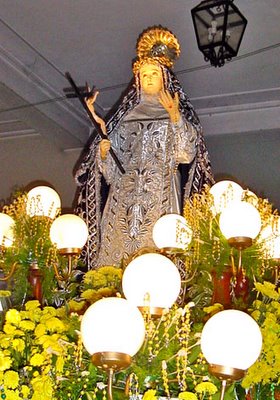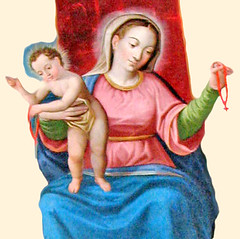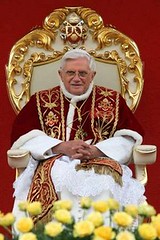The Mystic Maid of Prato
 Today the Dominican Family rejoices in the memory of a mystic and a sister of the Third Order of St Dominic, St Catherine de' Ricci (her statue from the La Naval Procession in Manila is shown on right). She was born in 1522 of a prominent and wealthy banking family of the Florentine republic. Baptised Alessandra Lucrezia Romola, from a very early age, as with the great mystical saints, she displayed a natural piety and a sweet serenity of soul. Her heart burned with ardent love for God and her intellect displayed an unusually advanced comprehension of divine matters; at the age of three she often went off in search of quiet places of recollection where she engaged in deep prayer and contemplation.
Today the Dominican Family rejoices in the memory of a mystic and a sister of the Third Order of St Dominic, St Catherine de' Ricci (her statue from the La Naval Procession in Manila is shown on right). She was born in 1522 of a prominent and wealthy banking family of the Florentine republic. Baptised Alessandra Lucrezia Romola, from a very early age, as with the great mystical saints, she displayed a natural piety and a sweet serenity of soul. Her heart burned with ardent love for God and her intellect displayed an unusually advanced comprehension of divine matters; at the age of three she often went off in search of quiet places of recollection where she engaged in deep prayer and contemplation.As is so often the case, Alessandra's piety and obvious devotion disturbed and annoyed her parents, but she persevered and the Lord appeared to her with Our Lady and virgin saints to encourage her and bless her. At the age of twelve she entered the sisters' convent of St Vincent at Prato and was clothed in the white habit of St Dominic in 1535 and given the religious name Catherine in honour of St Catherine of Siena, for whom she had great love and admiration.
Upon entry into religious life, the Lord kept her grounded in humility. It seems that He kept her in continual conversation with Himself so that she was completely abstracted from earthly matters. Hence, she persistently failed in the outward observances of the Rule and appeared unable to attend to her manual labours or chant in the Office! The community despaired of this novice and yet the saint persisted in humility, bearing the rebukes of the community. When it became clear that the community wanted to send her away from the convent, St Catherine stormed heaven with her prayers and engaged in penances which enabled the community to allow her to make Profession!
St Catherine had a great devotion to Fra' Girolamo Savonarola, the prophetic Dominican friar who had stirred such controversy in Florence only years earlier. However, it seems that he appeared to her in visions and healed her of illness and under his inspiration she promoted the regular life of the convent.
Burning with love for the Holy Spirit and incessantly seeking the glory of God, in 1541, her fervent prayers were answered and she was given a new heart, fashioned after the Immaculate Heart of Mary. From then on, an ethereal mystical quality surrounded her and she experienced a 'mystical espousal' to Christ and then received the stigmata and finally she experienced weekly ecstasies of the Passion, at which she was mystically present. These phenomena continued for twelve years and came under investigation by the Order and the Holy See. The commission which investigated her declared that the "extraordinary graces of which they themselves had just been witnesses constituted a most striking demonstration of the truth of the Catholic faith."
She twice served the as prioress, governing the community with exemplary prudence and kindness. However, she did have the most unusual counsellors; she received visits from Our Lady, St Dominic, St Vincent Ferrer and St Thomas Aquinas and other saints who would counsel her on matters of importance. She was also filled with a zeal for souls and she wrote letters and prayed for many. Among her letters which remain are those to St Philip Neri, St Charles Borromeo and St Mary Magdalen de' Pazzi. In this regard she mirrored St Catherine of Siena and also in the fact that many influential people began to call upon her for advice and to seek her prayers.
Her spirituality was typically Dominican, balancing her contemplation and mystical experiences with her passion for souls and an active letter-writing apostolate. Heresy and violence were a source of deep concern to her and she offered her sufferings in expiation for these sins; an expression of her love for humanity. At the same time, she had a deep love for Jesus in the Eucharist and His Passion. Next in her heart was Our Blessed Mother and then her ardent love for the souls in Purgatory, for whom she prayed ceaselessly.
St Catherine de' Ricci died in Prato on 2 February 1590 and she was canonized by Pope Benedict IX on 29 June 1746.
This holy virgin's deep love for God and neighbour and her contemplation of the Passion of Christ is an example we can aspire to imitate in some way. She truly bore in her own flesh the sufferings of Christ and, like her Master, she offered her sufferings for the salvation of souls as an expiation for their sins. Thus we can sing of her in the Magnificat antiphon: "The wise virgin, Catherine, sharing in the sufferings of Christ, trimmed her lamp; when the Lord came, she went in with him to the marriage feast." By her prayers and God's grace, may we too join her there one day!







7 Comments:
Why did you say she was in the Third Order? She was a professed religious--Second Order.
???????????????
Faith
This is common misunderstanding. In the Order of Preachers until 1974, the First Order referred to the friars; the Second Order to the enclosed nuns; the Third Order to associations of laity who had their origins in lay penitential movements.
Hence, they were also called the Order of Penance of St Dominic. Some of the Order's most famous saints belong to the Third Order: St Catherine of Siena & St Rose of Lima to name but two. Indeed, St Catherine de Porres is patroness of the Third Order of St Dominic.
Members of the Third Order took the habit of St Dominic but with a black scapular and black capuce for the men, white veil for the women.
Initially the Third Order was intended for people who sought perfection in the world while living in their own families and homes but it was also followed by women who embraced community life and so formed houses of their own. St Catherine of Siena's life mirrors this.
Third Order communities were not enclosed nuns or monks so the members who lived according to the rule were not obliged to the enclosure. They often attended Mass and the Office in a nearby church and, besides their religious exercises, performed works of charity, especially care of the sick. In this pattern we have the nucleus of our apostolic OP sisters. The status of these communities was not uniform during the Middle Ages and well into the modern period. Some took vows, others did not. Only in 1509 did the pope allow them to take religious vows and thus be properly termed as 'professed religious'. Even so, they remained in the Third Order.
All the apostolic sisters trace their lineage in this way and as such, St Catherine de' Ricci, who was not an enclosed nun, was also of the Third Order.
Properly speaking, the Order of Preachers no longer has a 'Third Order'. Instead there are Dominican Laity and Dominican sisters and Dominican nuns as well as the Dominican frairs.
Some confusion may have arisen because Third Order is still thought of as 'lay' and St Catherine was living in a convent, which was a Third Order house in Prato.
I'm even more confused. Isn't St. Catherine of Siena the Patroness of the Third Order.
I do understand (thanks for the explanation) why St. Catherine de Ricci is Lay,) but your two last sentences confuse me. You say there are Dominican Laity and...
But then you end with the "Third Order is still thought of as lay..."
Also adding to the confusion is my own frame of reference. I'm from the Eastern USA Province, St. Joseph, and our Provincial Promoter prefers that we call ourselves "Third Order," because we have some diocesan priests and deacons among our membership. Hence, I am: Faith Flaherty, T.O.P.. However, the Western Province refers to itself as Dominican Laity. Hence, Karen Woods, O.P.L.
What's in a name? A rose by any other name....
Faith
(I think)
Firstly, I acknowledge a typographical error in my reply to your comment: It is St Catherine of Siena of course who is Patroness of the Third Order, as you rightly say.
In my opinion, T.O.P. is a vestigial term that should not be used because it creates confusion. Since the 1974 General Chapter did away with the three ranks of orders in the OP Family, we should stop using T.O.P.
I think O.P.L. is just as awkward. What is wrong with just Faith Flaherty, O.P.? Are we not all members of one Dominican family? I call myself Fra' Lawrence, O.P. to distinguish that I am a friar and Br Lawrence, O.P. to note that I am not ordained. An apostolic sister or nun would be Sr Catherine, O.P. So, I see no need for O.P.L. or T.O.P...
Now to explain myself and what I wrote: When I said "the Third Order is still thought of as lay" I meant that many people, when hearing the term Third Order think of T.O.Ps (such as yourself) and equate it with the laity. That would be right if we were speaking of post-1974 persons but not always right if we were speaking about people after 1509; as I noted above, after 1509, some took religious vows.
This only highlights why it is confusing for some provinces to use 'T.O.P.' as a term for lay Dominicans today because non-Dominicans (and even some of the OP Family) will think that all T.O.Ps in the history of the Order were laity in the sense that we now understand laity. This is clearly not so since some T.O.Ps in the past took religious vows.
In fact, in current terminology, we would call St Catherine de Ricci a consecrated person who was a member of the Third Order of Preachers. She is not 'lay' in the popular understanding of that word, by which we mean someone who is not in religious vows and/or ordained.
There is however a further complication if we consider that Vatican II only distinguishes between ordained and non-ordained, thus all non-ordained are 'lay' in the canonical and technical understanding of the word. I believe that popular understanding classes the religious as a middle ground between lay and clerical states! Thus, according to the technical understanding of the word 'laity' all of us in the Order who are not ordained are laity!
Hence, I see little point in the usage of O.P.L. or T.O.P. in our current context as a means of distinguishing those who are not in religious vows. Canon law would regard the vast, un-ordained majority of us in that category. So why not just use simple un-embellished: O.P.?! And use 'Father' to distinguish the ordained OPs, if so desired.
Yes, its a little confusing, which is why we need to clarify the jargon.
For the purposes of this post, we just need to know that St Catherine de Ricci was a member of a Third Order community within her historical context and that the Dominican Laity and Sisters, as we now call what used to be the Third Order of St Dominic, have a proud lineage of saints!
Now, I hope that was all as clear as mud!! :)
LOL Yes, and Thank You.
Mrs. Faith Flaherty, O.P.
Um... if Br. Lawrence and St. Catherine will pardon it, the Dominican Province of St. Joseph uses T.O.P., not to distinguish those who are not in religious vows, but to distinguish members (including priests and deacons! and consecrated virgins!) of the Lay Fraternities of St. Dominic.
As I understand it, the decision was made as a reminder to Lay Dominicans of the Province that we are not playing at being friars and nuns, but have our own role within the Order.
The last word I heard out of Rome on the matter -- though this was some years ago, so it may have changed -- was that as-was-tertiaries should append "O.P. (professed)," a construction I have never yet witnessed in the wild.
It never ceases to amaze me that the Order entrusted with the legacy of St. Thomas, Doctor of Distinctions, can't seem to figure out its own structure, even as a purely descriptive matter. It's a mark, I suppose, of the fecundity of the Spirit's work in distributing the charism of preaching.
Thank you Tom... however, should it not be L.F.O.P.? Whence the T in T.O.P. except for the now (sadly) extinct Third Order?
I say bring back the three orders... that would simplify matters. It wasn't broke so why did we 'fix' it?! A friar here in our community recently remarked that there is nothing hierarchical or class-based in the old language of 1st, 2nd and 3rd Orders just as there is no subordination in the persons of the Trinity who are also named as 1st, 2nd and 3rd persons...
Frankly, if we are to remain one family or communion, one Order of Preachers, I believe we should all bear O.P.
Of course we all have our own role within the Order and being O.P. does not blur those roles any more than to bear the noble name of being 'Christian'!
Let us not make a distinction when none are truly necessary or where such a distinction sets up an artificial or politicized dichotomy where none should exist.
Anyway, enough on this. It is for the individual Province to decide what is appropriate.
Pax tecum.
Post a Comment
<< Home